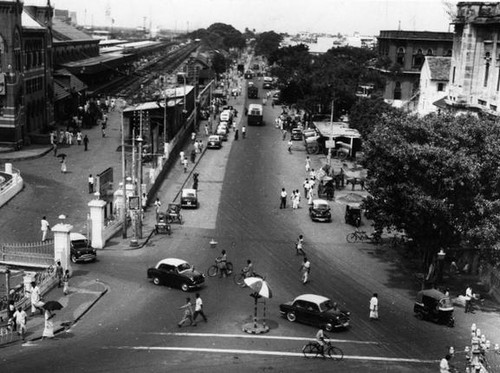OP
OP
swathi25
Guest
[h=1]கத்தி பாரா முதல் கோடோ பாக் வரை (மெட்ராஸ் நல்ல மெட்ராஸ் - 12)[/h]
-தமிழ் மகன்
ஓர் இடம் தொன்மையானது என்பது அதன் காரணப் பெயரால் அறியப்படும். பள்ளத்தூர், குன்றத்தூர், குளத்தூர், மேட்டூர், பனையூர், ஆத்தூர், நெல்லூர் போன்ற சிற்றூர்கள் முதல் திருச்சிராப்பள்ளி, தஞ்சாவூர், மதுரை, கோயம்புத்தூர், திருநெல்வேலி, காஞ்சி போன்ற பல பேரூர்களுக்கும் அத்தகைய பெயர்க் காரணங்கள் உண்டு. பிற்கால சோழர்கள் காலந்தொட்டு அரசர்கள் பெயரை ஊர்களுக்கு வைக்கும் வழக்கம் ஏற்பட்டது என்கிறார்கள் ஆய்வாளர்கள். சுந்தர சோழபுரம், ராஜராஜேச்வரம், கங்கைகொண்ட சோழபுரம் என பெயர்கள் வைத்ததாகச் சொல்வார்கள்.
பிரிட்டீஷார் காலத்தில் சில ஊர்கள் சிதைந்தன. திருவல்லிக்கேணி ட்ரிப்ளிகேன் ஆனது, தஞ்சாவூர் டேன்சூர், திருச்சிராப்பள்ளி ட்ரிச்சி என பிரயோகிப்படுவது நாகரிகமாகிவிட்டது.
வந்தவாசியில் கவிஞர் அ.வெண்ணிலா ஒரு கூட்டத்துக்கு ஏற்பாடு செய்திருந்தார். வந்தவாசி என்றால் என்ன என்று கேட்டேன். அவர் சொன்ன காரணம் வித்தியாசமானது.
வெள்ளையர் ஆட்சிக் காலத்தின்போது, ஒரு வெள்ளைக்காரர் அந்த ஊரின் பக்கம் வந்தார். அவருக்கு ஊரின் பெயரை தெரிந்துகொள்ள வேண்டும் என்று ஆசை. அங்கே குளத்தில் நின்றபடி மாட்டு வண்டியைக் கழுவிக்கொண்டிருந்தவரிடம் 'ஊரின் பெயர் என்ன?' என ஆங்கிலத்தில் கேட்டார்.
நீ என்ன செய்கிறாய் என்று கேட்டதாக அர்த்தம் பண்ணிக்கொண்டு, 'வண்டி வாஷ்' என்றாராம் அரைகுறை ஆங்கிலத்தில். ஆங்கிலேயரும் ஊரின் பெயரை வண்டிவாஷ் என்று குறித்துக்கொண்டு போனாராம். அதுதான் வந்தவாசி என்று ஆனதாம்.
.jpg)
மேலும் படிக்க https://www.vikatan.com/news/writer/46048.html
Courtesy: Vikatan
-தமிழ் மகன்
ஓர் இடம் தொன்மையானது என்பது அதன் காரணப் பெயரால் அறியப்படும். பள்ளத்தூர், குன்றத்தூர், குளத்தூர், மேட்டூர், பனையூர், ஆத்தூர், நெல்லூர் போன்ற சிற்றூர்கள் முதல் திருச்சிராப்பள்ளி, தஞ்சாவூர், மதுரை, கோயம்புத்தூர், திருநெல்வேலி, காஞ்சி போன்ற பல பேரூர்களுக்கும் அத்தகைய பெயர்க் காரணங்கள் உண்டு. பிற்கால சோழர்கள் காலந்தொட்டு அரசர்கள் பெயரை ஊர்களுக்கு வைக்கும் வழக்கம் ஏற்பட்டது என்கிறார்கள் ஆய்வாளர்கள். சுந்தர சோழபுரம், ராஜராஜேச்வரம், கங்கைகொண்ட சோழபுரம் என பெயர்கள் வைத்ததாகச் சொல்வார்கள்.
பிரிட்டீஷார் காலத்தில் சில ஊர்கள் சிதைந்தன. திருவல்லிக்கேணி ட்ரிப்ளிகேன் ஆனது, தஞ்சாவூர் டேன்சூர், திருச்சிராப்பள்ளி ட்ரிச்சி என பிரயோகிப்படுவது நாகரிகமாகிவிட்டது.
வந்தவாசியில் கவிஞர் அ.வெண்ணிலா ஒரு கூட்டத்துக்கு ஏற்பாடு செய்திருந்தார். வந்தவாசி என்றால் என்ன என்று கேட்டேன். அவர் சொன்ன காரணம் வித்தியாசமானது.
வெள்ளையர் ஆட்சிக் காலத்தின்போது, ஒரு வெள்ளைக்காரர் அந்த ஊரின் பக்கம் வந்தார். அவருக்கு ஊரின் பெயரை தெரிந்துகொள்ள வேண்டும் என்று ஆசை. அங்கே குளத்தில் நின்றபடி மாட்டு வண்டியைக் கழுவிக்கொண்டிருந்தவரிடம் 'ஊரின் பெயர் என்ன?' என ஆங்கிலத்தில் கேட்டார்.
நீ என்ன செய்கிறாய் என்று கேட்டதாக அர்த்தம் பண்ணிக்கொண்டு, 'வண்டி வாஷ்' என்றாராம் அரைகுறை ஆங்கிலத்தில். ஆங்கிலேயரும் ஊரின் பெயரை வண்டிவாஷ் என்று குறித்துக்கொண்டு போனாராம். அதுதான் வந்தவாசி என்று ஆனதாம்.
.jpg)
மேலும் படிக்க https://www.vikatan.com/news/writer/46048.html
Courtesy: Vikatan







